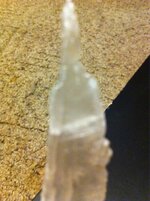Navigation
Install the app
How to install the app on iOS
Follow along with the video below to see how to install our site as a web app on your home screen.
Note: This feature may not be available in some browsers.
More options
You are using an out of date browser. It may not display this or other websites correctly.
You should upgrade or use an alternative browser.
You should upgrade or use an alternative browser.
Natual Glass found in texas sand quarry
- Thread starter zoienluv
- Start date
DanKnug
Full Member
- Jun 15, 2013
- 106
- 48
- Detector(s) used
- ATPro
- Primary Interest:
- Metal Detecting
Zoie, the information Plumbata has provided is correct. I would venture that Plumbata is either a Geologist or someone with a strong interest in mineralogy.
Your area is a prime hunting ground for ammonites. Have you found any of those around? My father found one a few years ago that he said was 3-feet in diameter in Whitney. Unfortunately, he just left it and did not bother to bring it back.
Your area is a prime hunting ground for ammonites. Have you found any of those around? My father found one a few years ago that he said was 3-feet in diameter in Whitney. Unfortunately, he just left it and did not bother to bring it back.
geologyjohn
Full Member
- Mar 18, 2009
- 210
- 98
- Detector(s) used
- WW2 mine detector, D-Tex Standard, D-Tex Deluxe, A.H. Pro Discriminator, various Whites, Fisher 1265-X, Fisher 1270, Fisher F75, Fisher Gold Bug,Tesoro Sand Shark. And maybe others that I forgot?
Gypsum/calcite. Geologyjohn.
Back-of-the-boat
Gold Member
- Apr 18, 2013
- 6,941
- 8,625
- Detector(s) used
- AT GOLD/Garrett /C.Scope cs4PI/Garrett(carrot) pro pointer/ 5x8 double d coil and sniper coil/Lesche digger/Lesche "T" handle shovel.
- Primary Interest:
- All Treasure Hunting
I have an area I get gypsum from and it looks the same.Very cool to see what the Earth will cough up isn't it.
zoienluv
Jr. Member
- Thread starter
- #24
Zoie, the information Plumbata has provided is correct. I would venture that Plumbata is either a Geologist or someone with a strong interest in mineralogy.
Your area is a prime hunting ground for ammonites. Have you found any of those around? My father found one a few years ago that he said was 3-feet in diameter in Whitney. Unfortunately, he just left it and did not bother to bring it back.
No I haven't an I agree with the gypsum I went an found sum more things about it an it explains a lot better thanks for helpin me I'm new at the huntin thing but love to learn about all the cool things I've found I have sum more things I will post to get sum help on I appreciate the help

zoienluv
Jr. Member
- Thread starter
- #26
The pieces are most likely Gypsum, or possibly Calcite, as DanKnug suggested. Considering how you can scratch it with your fingernail, it is almost certainly Gypsum. It occurs in several forms with different names, but the clear/translucent masses like the ones your son discovered, or clear slender needle-like crystals of hydrated calcium sulfate (Gypsum), are often referred to as "Selenite". If you scrape an example and collect a bit of powder to mix with vinegar, not much should happen if it is Gypsum, though if it is Calcite it will react and visibly bubble.
Crystalline gypsum can form in many sedimentary environments in a "geologically" short period of time. I've collected rosettes in Miocene deposits of compressed sand and clay, with fossilized shark teeth coming from the same area. Since the material you have came from a sand mine (sedimentary deposit) it is highly unlikely that it is quartz or another silicate mineral, as it would be very unlikely that a layer of quartz/glass/fused silica could form between undisturbed layers of "loose" sand, as far as I understand. If one is not too familiar with minerals though, it would certainly make sense that a similar-looking rock is made of the same stuff as the sand above and below.
The core fact here is that a fingernail can scratch the mineral, implying that it has a Moh's hardness of less than 3/10. The hardness of a fingernail is around 2.5-3/10, Gypsum is 2/10, Calcite is 3/10, Iron is around 5/10 I think, and Quartz/SiO2 has a Moh's hardness of 7/10, which clearly rules it out.
Anyway, those are nice specimens, it is great that your son thought they were interesting and saved them!
Plumbata
I have a question the one thing I seen people sayin is selenite what is that I can't find anything on that word where would I find more info . If u can help me or direct me in that direction it would awsume. An thanks for helpin me out

riverdiver
Full Member
- Sep 27, 2011
- 212
- 364
- Detector(s) used
- Whites Classic5 ID
White's Surf Master II with the dive rod
Garrett Treasure Ace 350
- Primary Interest:
- All Treasure Hunting
Awesome recovery, to the person who talked about lightning created glass, those formations I believe are called Fulgramites and they form as tubes, alot like lava tubes. Anyway, great find, not high jacking the thread, just adding info.
Top Member Reactions
-
 3527
3527 -
 2089
2089 -
 2049
2049 -
 1158
1158 -
 1113
1113 -
 927
927 -
 848
848 -
 823
823 -
 818
818 -
 782
782 -
 770
770 -
 543
543 -
 531
531 -
 453
453 -
 452
452 -
 446
446 -
E
424
-
 413
413 -
 410
410 -
 404
404
Users who are viewing this thread
Total: 2 (members: 0, guests: 2)




















